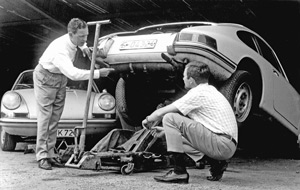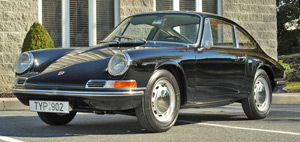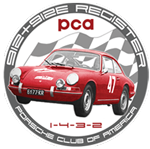The 902 Decision
As Porsche refined the design of the six-cylinder Type 901 [later
911], it became clear that production costs would drive 901 retail
prices significantly higher that the standard Type 356. To
assure sufficient sales, in 1963 Porsche executives decided to also
introduce a four-cylinder version, to be known as the Type 902
[later 912]. With Autumn 1964 911 introductory sales figures
unstable, to the rescue came the 912 option in April 1965.
Porsche brought 912 pricing close to the 356 by installing a
four-cylinder engine, plus making optional some features standard on
the 901.
The 902 Engine
Porsche's Carrera 2 four-cylinder engine, though 2.0 liters and 130+
HP, was too complex and costly for the 902. Therefore Porsche
first considered designing a completely new four-cylinder engine for
the 902, utilizing components from the new 901 six-cylinder.
Paul Hensler (later Porsche Chief Engineer and leader of development
of engines and drives) joined the engine construction department on
April 1, 1963 and took the project as his first street car engine
design. Because the new 901 engine was 2.0 liters, using those
components would result in a 1.3 liter four-cylinder version.
Even a 1.5 liter version would only have produce about 100 HP;
therefore Porsche shelved this design concept.
Another option explored by Claus von Rucker in mid-1963 was to
modernize the 356 Type 616 engine by increasing displacement to 1.8
liters, adding Kugelfischer fuel injection, and modifying both valve
and cooling systems. By the influence of the Sales Department,
this project was shelved when cost calculations by Hanz Mezger did
not support further development.
 Ultimately a new, refined version of the 356SC's Type 616/16 90 HP
engine was tailored for the 902, with a modified exhaust system,
slightly lower compression ratio, new carburetors and air cleaners,
and an oil cooler inside the fan shroud. The 902's engine, known as
the Type 616/36, produced five less horsepower than the 616/16, but
delivered about the same maximum torque at 3,500 rpm versus 4,200
rpm for the 616/16. For countries with lower speed limits such
as the United States, the 616/36 engine proved sufficient and
reliable. And the Type 616/36 solved a second challenge for
Porsche: by 1963 sales of Porsche industrial engines, based on the
356 Type 616, had dropped; but due to supply and production
agreements Porsche needed to continue manufacture of these engines. Ultimately a new, refined version of the 356SC's Type 616/16 90 HP
engine was tailored for the 902, with a modified exhaust system,
slightly lower compression ratio, new carburetors and air cleaners,
and an oil cooler inside the fan shroud. The 902's engine, known as
the Type 616/36, produced five less horsepower than the 616/16, but
delivered about the same maximum torque at 3,500 rpm versus 4,200
rpm for the 616/16. For countries with lower speed limits such
as the United States, the 616/36 engine proved sufficient and
reliable. And the Type 616/36 solved a second challenge for
Porsche: by 1963 sales of Porsche industrial engines, based on the
356 Type 616, had dropped; but due to supply and production
agreements Porsche needed to continue manufacture of these engines.
902 Prototypes
 Building a series of prototypes [pre-production test cars] gave
Porsche executives confidence that their cars were nearly ready for
production and sale. Before 901 production commenced in
September 1964, the Porsche Vehicle Research Department had also set
aside chassis numbers 13328, 13329, 13330, and 13352 for 902
prototype cars. Building a series of prototypes [pre-production test cars] gave
Porsche executives confidence that their cars were nearly ready for
production and sale. Before 901 production commenced in
September 1964, the Porsche Vehicle Research Department had also set
aside chassis numbers 13328, 13329, 13330, and 13352 for 902
prototype cars.
902 chassis Number 13352
(902/11), was manufactured by Karmann in Osnabruck and delivered to
Porsche on June 29, 1964. In running
condition by September 17, 1964, Number 13352 was initially equipped with a
four speed transmission with ratios similar to a 356SC, and Teves
brakes. Registered with license S-UP 934 in December
1964, it was tire tested at Hockenheimring, Germany in late
September and early October, and personally driven by Ferry
Porsche to Wolfsburg October 7-8, 1964. Number 13352
continued to be used for noise and damper test through June 1965;
Porsche sold 13352 on September 17, 1965.
902 chassis Number 13330
(902/10), manufactured by Hausele, was in running condition by
October 2, 1964, using engine number 830001, four speed
transmission, Goodyear 695-15 HE tires, and Teves brakes.
Registered with license S-UP 935 in December 1964, Number 13330 was
tested at Monza, Italy that month. In January 1965 Porsche
conducted endurance and heater tests, and the suspension was further
refined in February 1965; Porsche sold Number 13330 on October 29,
1965.
902 Research Cars
After the first production car,
any car that needs an improvement is given a "running change."
Cars devoted to testing after production begins are called
versuchwagens [research
cars], rather than prototypes. Porsche designated chassis numbers 13386 through 13397
for research testing of the 902.
 Noted
automobile restorer Dennis Frick restored historically significant
Porsche 902 Versuchwagen Serial Number 13394,
the oldest 902 known to exist today, now shown at
prestigious events such as the Amelia Islands Concours d'Elegance.
Dennis provided information about Number 13394 that notes in part: "This prototype
has several features not found on production 912 Porsches. Its
mechanical sunroof is operated by a crank handle, which employs spur
and bevel gears, enabling the sunroof panel to lower and slide
forward. (The production 911/912 sunroof, in contrast, is electric;
it lowers and opens to the rear.) Because of its unusual sunroof
design, this car has, concealed behind the headliner, hand-formed
wooden platforms for the sun visors. A similarly shaped block
supports the interior mirror. In the dashboard, three gauges with
356 style bezel are fitted. Also in evidence is a hand-cut
steering lock, suggesting that such devices were tested on this
vehicle. In the trunk are six sturdy hooks, two fastened to each of
the inner fender wells, and two attached to the latch plate. The
hooks are held in place by sheet metal screws, indicating that this
was the first car so equipped. (A few very early production cars
have similar hooks welded in position.) Members of the factory
vehicle research team active during the 901/902 development state
that they often fitted the four cylinder prototypes with extra fuel
containers in the trunk for long distance testing. It is though
that the six hooks were initially installed for this purpose." Noted
automobile restorer Dennis Frick restored historically significant
Porsche 902 Versuchwagen Serial Number 13394,
the oldest 902 known to exist today, now shown at
prestigious events such as the Amelia Islands Concours d'Elegance.
Dennis provided information about Number 13394 that notes in part: "This prototype
has several features not found on production 912 Porsches. Its
mechanical sunroof is operated by a crank handle, which employs spur
and bevel gears, enabling the sunroof panel to lower and slide
forward. (The production 911/912 sunroof, in contrast, is electric;
it lowers and opens to the rear.) Because of its unusual sunroof
design, this car has, concealed behind the headliner, hand-formed
wooden platforms for the sun visors. A similarly shaped block
supports the interior mirror. In the dashboard, three gauges with
356 style bezel are fitted. Also in evidence is a hand-cut
steering lock, suggesting that such devices were tested on this
vehicle. In the trunk are six sturdy hooks, two fastened to each of
the inner fender wells, and two attached to the latch plate. The
hooks are held in place by sheet metal screws, indicating that this
was the first car so equipped. (A few very early production cars
have similar hooks welded in position.) Members of the factory
vehicle research team active during the 901/902 development state
that they often fitted the four cylinder prototypes with extra fuel
containers in the trunk for long distance testing. It is though
that the six hooks were initially installed for this purpose."
"Additionally, it is believed that some long distance testing of
chassis components was done utilizing this car, which has its
original engine, number 821118. The engine is an air-cooled,
horizontally opposed, 1.6 Liter pushrod four cylinder unit producing
95 DIN horsepower, taken unaltered from the 356 SC."
"While the exact disposition of every 902 prototype is
unknown, it is known that some were destroyed in testing, some were
scrapped, and some were sold to employees. The advent of the longer
wheelbase model (B Series) marked the end of this car's usefulness
to the research department. Factory archive records indicate that it
was sold in 1967."
Jurgen Lewandowski's book Porsche 901: The Roots of a
Legend, notes that 902 chassis
Number 13396 was the second Targa
test car, undergoing the first extensive test drive with Rolf Hannes
from the Test Driving department on June 9, 1965. Although the
idea of the Targa dated as far back as 1962, on August 11, 1965,
Porsche finally registered the roof design with the patent office
under file reference 1455743.
The Results
Compared to the 901/911, the production Type 912 vehicle
demonstrated superior weight distribution, handling, fuel efficiency
and range. As noted by Jurgen Lewandowski in Porsche 901:
The Roots of a Legend, "The decision to bring out a
four-cylinder alongside the six-cylinder variant turned out to be
the right one, because many buyers liked the shape of the 911, but
did not really want that much power. The result was no less than
6401 buyers opting for a 912 the year it was introduced; exceeding
the sales figures for the 911 by more than 100 percent."
Research Credits and References
Thanks to the Porsche Factory Archive Department; Dennis Frick of Europa Macchina,
Lewisberry, Pennsylvania, USA; Jurgen Lewandowski, Germany; and the
Klassieke Porsche 911 & 912 Club Nederland for information
included on this page. |
 C
C C
C